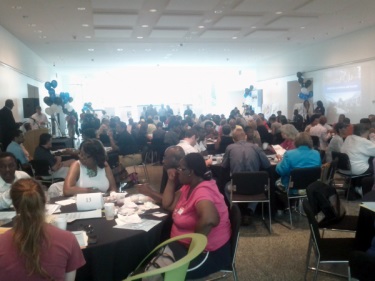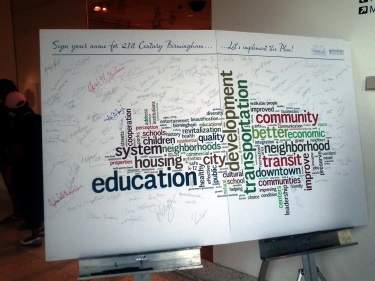 It was one of those things where you just felt the level of optimism surrounding you (even as some skepticism tried to sneak in from time to time) and got infected by it. There were approximately 250 people gathered at the Birmingham Museum of Art on Saturday morning to learn about the current status of the city’s first comprehensive plan effort since 1961.
It was one of those things where you just felt the level of optimism surrounding you (even as some skepticism tried to sneak in from time to time) and got infected by it. There were approximately 250 people gathered at the Birmingham Museum of Art on Saturday morning to learn about the current status of the city’s first comprehensive plan effort since 1961.
Community leaders from across the city shared breakfast and opinions with the consulting team and the plan’s steering committee (of which I am a part). Yes, I focused on community leaders first. There were only four (4) citywide elected officials in attendance out of a possible 19 on Saturday morning at various points; Birmingham mayor William Bell; city councilors Valerie Abbott and Jay Roberson; and Birmingham Board of Education member April Williams.
The current implied timetable for this effort means that we’ll be starting to look at some of the broader issues next year – so long as its adopted before the end of this one. It also means that it could be used as a measurement tool to hold elected officials and our numerous community organizations accountable, also known as an election year issue. This is where I remind you that in the midst of next year’s commemoration of the events of 1963 (by the way, it’s a Flash-based site), we’ll be choosing who we want to have lead the city forward at the beginning of the next 50 years – in the mayor’s office, all nine city council districts, and the Board of Education.
It’s my hope that the comprehensive plan becomes the kind of issue where we’re asking for our elected officials to voice their continued support for it instead of it being used as a political football. Hopefully as more of our elected officials become familiar with the plan, it’ll make it harder for them to do the former (though not impossible).
 We have a chance to offer comment once the draft is released, though for those of you reading this, clicking through to the plan’s website will also enable you to know what’s been going on. There are opportunities to read through materials at the Birmingham Public Library for those who’ll suggest that they can’t find their way to a computer. There isn’t an excuse to not participate just like there wasn’t an excuse to do so during the holidays despite freezing temperatures and the likelihood of snow.
We have a chance to offer comment once the draft is released, though for those of you reading this, clicking through to the plan’s website will also enable you to know what’s been going on. There are opportunities to read through materials at the Birmingham Public Library for those who’ll suggest that they can’t find their way to a computer. There isn’t an excuse to not participate just like there wasn’t an excuse to do so during the holidays despite freezing temperatures and the likelihood of snow.
Most impressive was the number of young people in attendance. Yes, there were young professionals scattered among the various tables, but there was a large contingent from UAB as well as a few area high school students – none of whom were afraid of having their voices heard and not necessarily agreeing with the adults in the room. It reminded me of the group of young people who presented their hopes and dreams for the city during the first public forum last fall. They know what they want to see in their city as it moves forward and of its potential. More than anything else, this plan is about their future and not about our legacy and we owe it to them to be involved and to get it right (and adopted) when the time comes.
You might say that those who attended and those children I’ve mentioned are not like most people in Birmingham; those who see a grand future for Birmingham think they aren’t like most people anyway. I’ve got a feeling they’re wrong though and they exist in greater numbers than most think. The key will be making sure they know their voice still matters and that there are several ways to share their comments.
What do you think?
Andre Natta is The Terminal’s stationmaster.





 The first time I met David Fleming, I was sitting across the table from him for about an hour on the tenth floor of
The first time I met David Fleming, I was sitting across the table from him for about an hour on the tenth floor of  This evening, organizers have planned for approximately 1,000 people to pass through the
This evening, organizers have planned for approximately 1,000 people to pass through the 

Maybe Larry was on to something…
Whenever someone brings up Langford’s name, there’s normally some snickering about several of his proposals and their effects on the city and surrounding community. There is none that draws giggling and snark quicker than his attempt to bid for the 2020 Summer Olympics.
If you approach it on face value, it didn’t make sense at all – at least it shouldn’t have. When it was presented in 2008, I suggested folks consider looking at it as a blueprint to measure his effectiveness as mayor. I got comments and emails from visitors to the site suggesting it was a noble interpretation, but the idea was still unrealistic.
I’ve left the notion alone now for the last 4+ years, thinking I may have missed something. Then, as I sat at my desk towards the end of last year, starting to shift my thoughts towards the city’s efforts to recognize what happened in 1963, it hit me. I’d found a new way to look at Langford’s proposals – one many wouldn’t want to acknowledge or admit to even if pressed. It was still compelling.
Langford’s proposals were his way of trying to get the city ready for 2013… and 2021.
Another look at Langford’s list of ideas
There is an entry dedicated to the list of initiatives proposed by Larry Langford throughout his political career maintained over on Bhamwiki. The collections of suggestions made during his time as mayor is extensive (and exhausting for some), but reviewed through the lens of getting a city ready for its international close-up, it is impressive.
Some, like the proposal to demolish the Birmingham Board of Education headquarters across from Linn Park to allow for redevelopment, sounded crazy, but now it appears as though it’ll happen now. Others, like suggesting we build fountains and plazas in Pratt City, Five Points West and downtown, seemed too far out there.
Now we get to the 2020 Olympics bid.
No, I’m not saying we had a chance, but it goes back to my original point from the June 2008 piece – it was a goal to place in front of the city. It was the ultimate target. It intrigued me as the math began to make sense. The proposal would have to go in during 2008, getting us media attention (which it did). There would have to be significant progress made on the infrastructure by late 2012/early 2013 at the latest, regardless of the situation in which Langford found himself. This would mean the city would be “ready” by 2013 – the moment Birmingham would once again be in the international spotlight for not just one, but two reasons.
It would provide a different angle for visiting journalists and bloggers to take on the city; it becomes less an issue of what we’re commemorating and more of where we are and where the city is going. It would also provide some buzz on which you could build on and realize several significant changes to the city for 2020, when journalists would undoubtedly come back to see if we’d taken advantage of those necessary improvements.
By the way, those improvements would have us ready for the following year, 2021. The significance of that year? It’s the 150th anniversary of the founding of Birmingham, AL.
I’m not asking you to anoint Langford a saint. I’m trying to demonstrate the madness had a method, albeit a haphazard one. It led to several of the things we’ll be celebrating and recognizing this year:
He asked us to do something, even though we didn’t necessarily want to play along. He will go down as a polarizing figure in Birmingham history, but he’ll also have a place in the hearts of some who’ve started to connect the insanity of the dots – as insane as they may be.
He even ended up scoring one of those proposed fountains downtown – over at our new Uptown entertainment district. The first groundbreaking – yeah, he was there, too.
André Natta is the stationmaster for bhamterminal.com.
3 Comments
Posted in Commentary, leadership
Tagged 1963, 2013, 2020 Olympics, Larry Langford, optimism